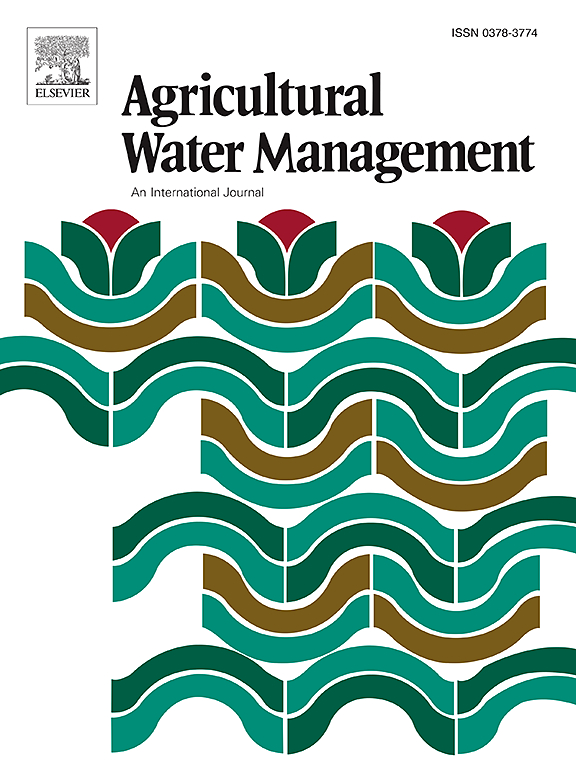Optimizing wheat supplementary irrigation: Integrating soil stress and crop water stress index for smart scheduling
IF 5.9
1区 农林科学
Q1 AGRONOMY
引用次数: 0
Abstract
A two-year field experiment was conducted to integrate soil moisture stress with the Crop Water Stress Index (CWSI) for optimizing irrigation in winter wheat (Triticum aestivum L.) under varying irrigation regimes. The study took place at the Water Technology Centre (WTC-02) of ICAR-IARI, New Delhi, where the climate shows a blend of monsoon-influenced humid subtropical and semi-arid conditions. Using a randomized block design (RBD), five irrigation treatments were applied: full irrigation and deficit irrigation (DI) at 15 %, 30 %, 45 %, and 60 % levels. Canopy and ambient air temperature data, along with vapor pressure deficit (VPD), were recorded using a developed integrated sensing device to empirically determine the lower baseline equations and upper threshold for CWSI computation at pre-heading and post-heading stages. The slope (m), intercept (c) of the lower baseline equation, and upper threshold (UL) for pre-heading and post-heading were found: m: −1.94, c: −1.33, UL: 1.92°C and m: −1.30, c: −2.37, UL: 2.0°C, respectively. Results showed that increasing water deficit levels led to significant reductions in grain yield, biomass production, and harvest index. A strong negative correlation (R² = 0.95 and 0.93) between mean seasonal CWSI and yield attributes highlighted the utility of CWSI in yield prediction under varying irrigation regimes. It is recommended to schedule irrigation based on the CWSI approach when CWSI ≥0.35 for optimum wheat yields. Integrating CWSI with soil moisture stress provides valuable real-time insights into crop water status, enabling more precise and smart irrigation scheduling.
优化小麦补充灌溉:整合土壤胁迫和作物水分胁迫指数,实现智能调度
进行了一项为期两年的田间试验,将土壤水分胁迫与作物水分胁迫指数(CWSI)相结合,以优化不同灌溉制度下的冬小麦(Triticum aestivum L.)灌溉。这项研究在新德里国际农业研究中心-国际农业研究所的水技术中心(WTC-02)进行,这里的气候混合了受季风影响的亚热带湿润气候和半干旱气候。采用随机区组设计(RBD),进行了五种灌溉处理:完全灌溉和赤水灌溉(DI),灌溉水平分别为 15%、30%、45% 和 60%。利用开发的综合传感装置记录了冠层和环境空气温度数据以及水汽压差(VPD),从而根据经验确定了喷头前和喷头后阶段计算 CWSI 的基准方程下限和阈值上限。结果发现,镦粗前和镦粗后的下基线方程的斜率(m)、截距(c)和上阈值(UL)分别为:m:-1.94, c:-1.33,UL:1.92°C 和 m:-1.30, c:-2.37,UL:2.0°C。结果表明,缺水程度的增加导致谷物产量、生物量产量和收获指数显著下降。平均季节 CWSI 与产量属性之间存在较强的负相关(R² = 0.95 和 0.93),凸显了 CWSI 在不同灌溉制度下预测产量的作用。建议在 CWSI ≥ 0.35 时根据 CWSI 方法安排灌溉,以获得最佳小麦产量。将 CWSI 与土壤水分胁迫相结合,可实时了解作物水分状况,从而实现更精确、更智能的灌溉调度。
本文章由计算机程序翻译,如有差异,请以英文原文为准。
求助全文
约1分钟内获得全文
求助全文
来源期刊

Agricultural Water Management
农林科学-农艺学
CiteScore
12.10
自引率
14.90%
发文量
648
审稿时长
4.9 months
期刊介绍:
Agricultural Water Management publishes papers of international significance relating to the science, economics, and policy of agricultural water management. In all cases, manuscripts must address implications and provide insight regarding agricultural water management.
 求助内容:
求助内容: 应助结果提醒方式:
应助结果提醒方式:


